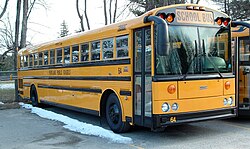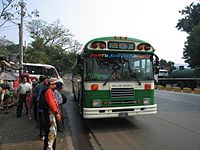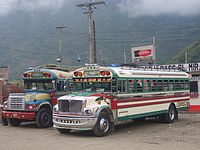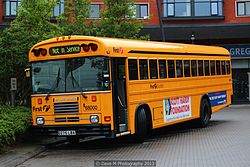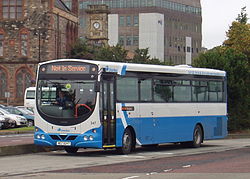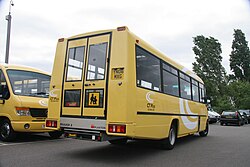利用者:Tatawidepine/sandbox/スクールバス
(17:39, 8 December 2012 UTC) を翻訳
この項では、アメリカ合衆国におけるスクールバスについて述べる。
概要
[編集]アメリカ合衆国においてschool busという語は「通学や郊外活動の際に生徒を乗せることを目的として設計・生産されたバス車両」を指し、1827年にイギリスで馬による牽引の25人乗りタイプが登場したのが発祥である[1]。
北米大陸では登場当初から連邦法や各州法などによってスクールバスは他のバスと外観で区別できるようにすることが義務付けられ、連邦安全規格(Federal safety standards)では、スクールバスは黄色(スクールバス・イエロー)の塗装と安全・警告のための独自の装備を有すことが要求された[2]。また、スクールバスの利用に際しては、保護者らに金銭的な負担を要求することはほとんど無い。アメリカでは単に「スクールバス」と言った場合は基本的に車両そのもののことを指すことが多いが、アメリカ以外では通学の便に供されるバス全体を指すことが多い。
アメリカでは、毎日48万台以上のバスが計2600万人、毎年のべ100億人の生徒を乗せて走っている。特に、郊外・田舎の生徒の半数以上がスクールバスを利用している[3]。 スクールバスは校区ごとにリース、購入されるなどして管理されているが、米国内の約40%の校区はスクールバス・コントラクター(スクールバスを代理運行する民間会社の一般名称)へ委託して運行している。
北米における車体の歴史
[編集]初期 (19世紀 - 1930年代)
[編集]馬車式
[編集]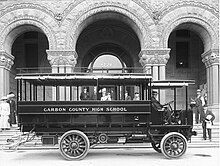
馬車式のスクールバスは英語でキッドハック(Kid hack)と呼ばれるが、ハックとは馬に牽引される車両の総称である[4]。
1837年アメリカにてウェイン・ワークス(ウェイン社の前身)が設立されたが、1880年までに、一般的にキッドハックと呼ばれる児童・生徒輸送用の馬車を生産する会社として知られるようになった。キッドハックの他、スクールハック(school hacks)、スクールカー(school cars)などとも呼ばれた。
“馬なし”スクールバスの理念は、キッドハックに続くものとして今でも続いているが、当初は馬車を牽引中の馬が驚くことのないような見た目で作られた。多くのキッドハックは、その外周に沿うようにしてベンチシートを設けていた。初期のスクールバスは、家と学校を行き来するのに子供がひとりで歩いて行くのに相当な距離を要するような地域(顕著な田舎)で供用された。 実際のところ、キッドハックと同様、トラックの荷台を拡張し、幌をかけただけのものにすぎなかった。
ガラス窓車
[編集]ウェイン・ワークスは、1920年代初頭という極めて初期に手巻式カンバス製カーテンの代わりにガラス窓を採用した事業者の一つであるが[4]、実際はギリッグ・ブロスがそれより以前にすでに開発から特許の取得まで至っている。「カリフォルニア・トップ」の名で知られたギリッグ・ブロスの意匠は、一定幅に窓枠で区切られ、上下開閉機構も付いた窓と、わずかにカーブし補強された金属製屋根が特徴である[5]。一方で、1930年代まで、ほかの事業者はカーテン式窓を採用し続けた[6]。1930年、ウェインはオール金属車体のスクールバスの生産を開始し[4]、クラウン車体も1932年、金属車体の「クラウン・スーパーコーチ」でウェインに続いた。スーパーコーチは76人乗りと、当時では最大定員を誇る車両であった。[7][8]
工業規格化 (1930年 - 1945年)
[編集]
1930年代、スクールバスはワゴンやトラックなどといった単なる既存の乗り物の改造に過ぎないものから、一つの乗り物の種類へと進化した。ギリッグ兄弟の「カリフォルニア・トップ」はスクールバス産業の拡大に一役買うこととなった[5]。スクールバスが自動車産業の一つの分野として一般的になるにつれ、各メーカーが独自に金属製車体の生産を行うようになった。
大量生産へ
[編集]スクールバスは注文生産が一般的であることから、大量生産は難しかった。また、スクールバスが一つの自動車の形式として発生したものの、広汎性のある工業規格がまだ設定されていなかったのである。 1939年、農村部教育のエキスパートであるフランク・W・シール博士によって結成されたコロンビア大学大学院教育学院の会議にて、スクールバスは大きな変化を遂げた。会議には公共交通関連の役人や車体・シャシー製造会社の代表、塗料会社が参加した[9]。その会議では、スクールバスの全部位に関して、外観から座席の配置まで全44の標準規格が定められたが、その規格の多くは各車体メーカー間の一貫性を生み、当時の大規模生産と同程度の製造コストや煩雑さの大幅な軽減につながった。
また、北米文化の中で今なおスクールバスを象徴する車体の標準色「スクールバス・イエロー」もこの会議の中で制定された。詳細は後述。
スクールバス・イエロー
[編集]この項は消す 先述した1939年の会議では、スクールバスの安全に関する事項も決定された。著名なものでは、スクールバス用の標準色「スクールバス・イエロー」がある。会議の出席者は、黄色を"夕暮れや早朝でも最も見やすく、車体のレタリングとの対比も容易"な色とした[9]。
現在、この黄色は世界的にスクールバスの意匠として認知され[誰によって?]ており、その代表的なものとしてアメリカ合衆国の「National School Bus Glossy Yellow」[2]や、カナダの一部地域の「クローム・イエロー」[10]などがある。 北米大陸外にて、特に国家的に定められたものではなくとも、スクールバスを黄色とする場合がある[11]。
戦後 (1945年-1980年)
[編集]
第二次世界大戦後、ベビーブームにより急速な人口の増加がみられ、即座に学校の建設を追い越すペースとなった。これに伴って都市でも田舎でも、スクールバスの需要が急増した。
スクールバスが当初の農村部地域の輸送を担うものから、都市内や近郊など人口密集地域でも使われるようになるにつれて、従来のスタイルから発展し、定員や操縦性を改善した「箱型スクールバス」、特別支援生徒の送迎や、狭隘路の運行に適した「小型スクールバス」の2つの新しい形態が生まれたが、トラックのシャシーを用いた従来型のスクールバスも多くの運行者によって以後数十年間引き続き使用された。
箱形車
[編集]
1930年代、クラウン車体、ギリッグ・ブロス、ウェイン・ワークスをはじめとするスクールバスメーカーは、大量輸送用に供される公共交通としてのバス(トランジット型)に影響を受け、前面が平坦なデザインのスクールバス[8]を開発した。現在の命名法の下では「D型スクールバス」として知られる。
前述の通り、クラウン車体は丈夫で多定員な初の箱型スクールバスを1932年に設計し、「スーパーコーチ」と名付けた。これは、多くのカリフォルニア州の校区が丈夫な乗り物を必要とする土地事情にあったためである。[8] 1948年、ブルーバード社の創設者アルバート・L・ルースは現在のブルーバード・オールアメリカンの祖である箱形車両を、1959年、ギリッグ・ブロス社はのちに西海岸の代表的スクールバスであるギリッグトランジットコーチ・スクールバスとなる、リアにディーゼルエンジンを搭載した箱形車両を開発した。[12]
クラウン車体により1932年の時点でD型は登場していたものの、実際に広く使われるようになったのは第二次世界大戦後のことである[8]。 1950年代、ベビーブーム時代に生まれた子供たちは入学し、生徒数は急増した。これにより校区はより細分化され、スクールバスの必要な台数も増加した。この解決策として呼び声がかかったのが箱形のD型車である。その形状を生かして定員を最大97人にまで増やし、車両の台数を減らすことによって、トータルの整備回数と運転士数をへらし、スクールバス購入にかかるコストも抑えた。結果として1950年代はD型の生産が急増したが、21世紀となった現在でも、トラックのシャシーを用いた従来型(C型)がアメリカ合衆国のスクールバスを席巻している。
小型車
[編集]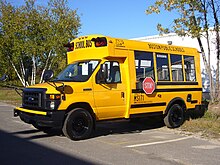
1960年代初頭、従来型のスクールバスは、メーカーがシャシーをピックアップトラックのものから中型トラックのものに変えたことにより、車内容量の増加が図られた。増えゆく需要によってより大型のバスが必要とされた一方で、大都市内の一部地域によっては、道路が狭隘なためにフルサイズ車による送迎が不可能な地域もあった。そこで、バンやSUVを改造して、スクールバスとしての要件を満たす車両が考えられた。1967年、最初の小型スクールバスがコリンズバス社によって発表され[13]、ウェイン・バセット社も1973年に同様の小型スクールバスを発表した。現在A型スクールバスとして知られるバンをベースとした車両と同時に、宅配バンやステップバンなどのシャシーをベースとした「B型」も製造された。こちらはA型よりやや大ぶり(日本の中型バスほどのサイズ)で、1977年から2005年にかけて生産されたブルーバード・ミニバードがそのひとつである。 A型は主にマグネットスクールやタレンテッド・ギフテッドの生徒、あるいは聴覚特別支援学校の送迎に使われるが、アメリカのスラングではこのA型バスを「ショートバス」と呼び、特別支援学校のスクールバスとして嘲笑的に語られる[14][15]こともある。実際特別支援学校の生徒の送迎には、車いす生徒用の自動昇降機が設置された車両が用いられ、精神・身体障害児に適切な対応を行える添乗員が乗車した車両が用いられ、A型であるとは限らない。
他の変化
[編集]1977年、連邦政府はスクールバスに関する多数の安全規定である「スクールバスのための連邦自動車安全規格[16]」を設けた。これにより、多くの車種について設計が見直されることとなった。その最たるものでは、背もたれを高くし、詰め物を増やすという改良要件がある。そのほか、車体の板金も、衝突安全性を考えてより丈夫なものとするよう命じられた。
2002年、米国運輸省道路交通安全局(NHTSA)は、国会に、スクールバスの安全に関する報告書を提出した。NHTSAの研究開発課はその報告書で「合衆国の生徒は親や保護者の乗用車に乗るよりスクールバスに乗る方が8倍安全である」とした。そのほか「乗用車の致死率が1.5/1億マイル走行に対し、スクールバスは0.2/1億マイル走行である」とも述べた.[17]。
スクールバス産業規模の縮小 (1980-2005)
[編集]20世紀末に近づくにつれ、経済的条件の多様化がスクールバス産業に影響を与えた。スクールバスの変化に合わせ、製造サイドも同様に変化を遂げた。
「6強」の終焉
[編集]
「6強」と謳われた1980年時点の北米の主要スクールバス車体製造メーカーは以下のとおり。
西海岸向けにスクールバス製造を行っていたクラウンとギリッグに加え、トラックを製造するフォード、GM、インターナショナルハーベスターから供給されたシャシーに架装する車体の製造を行っていた「6強」が存在していた(コーチビルダー)。 ところが1980年代から1990年代にかけ、破産したり買収されるメーカーも出てきた。この間にスクールバス製造業に新たに参入する業者はほとんどいなかったが、その一つ、フライトライナー・トラックスは、90年代後半にシャシーの提供を行った。「6強」と並び称されたものの内、2005年までに残存しているのは、ブルーバード、トーマス、ICコーポレーション(ウォード→アムトラン→ICコーポレーション)の3つのみである。
他の変化
[編集]1970年代に起きたオイルショックの影響で、省エネ性能のスクールバスの開発が始まった。1980年代、各メーカーは各型に対し、オプションとして、出力や燃費でガソリン車に圧倒的に勝るディーゼルエンジンタイプも選択できるようにした。この当時スクールバスはガソリン車が主流で、ディーゼルエンジンはD型車にのみ搭載されるものであった。1986年、ナビスター・インターナショナル社が初めてガソリンエンジンを搭載しないことを前提としたシャシーの開発をしたのをきっかけに、他社も追随し、1990年代中期までには、フルサイズ車体のガソリン車は完全にディーゼル車によって置き換えられた。
その他、1980年代より、運転手のために操作性を高める改良も多々施された。
とくに人間工学に基づいた改良はウェイン・ライフスター社によって行われ、その技術を用いたブルーバード・TC/2000と トーマス・セイフティーライナーMVPも予想をはるかに上回る売り上げを博した。1996年にはアムトラン社が初の低コスト・リアエンジンドライブ式の車両インターナショナル・3000(アムトラン・RE)を発売した。
2001年、カーペンター社の事業終了後、ゼネラル・モータースとフォードもフルサイズのスクールバス製造からだんだんと遠のいて行った。カーペンター社が1998年に最後のバス用シャシーを製造した後、ブルーバードにシャシーを提供するというフォードとの合意は2002年に破棄された。シャシーの提供先が見つからなくなったGMも、2003年にフルサイズバス用のシャシーを製造したのが最後となった。今日、GMとフォードはA型車のシャシー供給のみを独占的に行っている状態である。
新時代 (2005年以降)
[編集]1980年代~1990年代にかけてのスクールバス製造会社の統合はその業界のあり方を変えるものであった。過去、スクールバス製造会社は、買い手が指定したシャシーに自社の車体を載せるという業態を取っていたが、その後の合併や買収でメーカーが組み立てられる組み合わせは減少していった。選択肢は大幅に削られたものの、これがスクールバスの製造革新につながっていった。
フルサイズ車
[編集]
もともとC型車は他車が製造したシャシーに車体を架装する形で製造されていたのだが、2004年、ブルーバードは初めて、一社完結型製造の車種を発表した。それがブルーバード・ビジョン(外観はオールアメリカンと同一)である。シャシーは専門の会社によって設計され、その製造は自社の工場で行っている。 同年、トーマスバス製造もセイフティーライナーC2を発表した。外観はフライトライナー・M2ビジネスクラスと似ているが、C2は車体とシャシーが一体的に設計されている。ビジョンもC2も、実際は出入口ドアまわりの視界の改善のために発表された車種である。
2008年、オールアメリカンの新デザインが2010年モデルとして発表され、これまで45年間のブルーバード製スクールバスのデザインを覆すものとなった。これに伴って、他の車種も若干の変更が加えられた。
2011年6月、ケベック州サン・ジェロームに本社を置くライオンバスがスパルタン・モータースの分離子会社、スパルタン・シャシー社と提携を結び、合衆国のスクールバス製造業に参入した。2社はC型スクールバスの製造に関する協定を結んだ[18]。ライオンバスは、コーベイル・バス社の前社長と前上級ボードアドバイザーによって設立された[19]。コーベイル・バス社はもともとシャシーから車体までの製造を行うスクールバスメーカーであったが、2007年、コリンズ産業により買収されて廃業となった。
小型車
[編集]小型バスの製造においては、2000年代末期に大きな変革を迎えた。ゼネラル・モータースが1990年代後半にP型シャシーの生産を終えると、既に減少傾向にあったB型車はほとんど見られなくなってしまった。実際のところ、小型スクールバスはすべてA型車となり、GMとフォードだけがシャシーの提供会社である。
A型スクールバスの単独製造メーカーでは最大級のコリンズ・バス社は、前述の通り2007年、カナダのスクールバスメーカーであるコーベイル社を買収した。コーベイルはコリンズの子会社となり、オハイオ州に拠点を置くミッドバス社と併合され、全製造ラインはカンザス州にあるコリンズの工場に統合された。
過去十年の間に、小型スクールバス製造業に参入したことで、様々な面から成功を収めた小規模の会社も存在する。その代表的なものに、スタークラフトバス社とトランステック社があり、いずれもまだ拡大を続けている。また、2009年後半、ブルーバードとジラルダン・ミニバスは合弁事業を開始したが、ブルーバードはフルサイズ車の製造開発に専念するべく、カナダにおけるジラルダン製品の製造のことも考えて、1975年より継続されてきたA型スクールバスの生産ラインを終了させた[20]今日では、ブルーバードはフルサイズ車のみを製造している。
他の変化
[編集]

2000年代後半には、スクールバスの環境性能や安全性能を向上させるべく、様々な新しい改良が施されるようになった。従来のディーゼル車に加え、ディーゼルハイブリッド車が発売されたり、3点式シートベルトが採用されるようになるなどした。また、車両前部の遮断機は1990年代後半には既に使用が開始され、多くの校区で導入された。その他、保護者にバスの位置情報を随時伝えるためのGPSトラッキング装置や、誤って生徒が車内に残ったまま入庫することを防ぐ警報装置も導入されるようになった[21]。
製造
[編集](11:25, 2 August 2014 UTC) を翻訳
スクールバスメーカーは二次製造業者であることが多いが、車体とシャシーが同一の会社で製造された車両も存在する。特に、D型は車体とシャシーが同一である方が一般的である。また、2013年には北米だけで3万6073台のスクールバス(前年比112.6%)が販売された[22]。
北米における製造事業者
[編集]アメリカ合衆国では現在、以下6つの事業者がスクールバスの製造を手掛けている。
このほか、カナダのライオンバスが、カナダとアメリカ合衆国向けにC型フルサイズ車の生産を行っている。
過去、ブルーバード、トーマス、ウェインなどといった一部の事業者はカナダにも生産拠点を持っており、カナダとアメリカの間で互いにスクールバス車両の輸出入を行っていた。
スクールバスの形式
[編集]北米では、スクールバスは4つの車体区分のもとで生産されており、それぞれトレードネームとアルファベットで区分される。北米のすべてのスクールバスは標準床が採用されている。 アメリカでは車体寸法の最大値が決められており、全幅102インチ(約2.6メートル)、全長45フィート(約13.72メートル)までとされている[23]。この規定にのっとり、現在スクールバスは最大90人まで乗車できるような設計がされている。
スクールバスの安全
[編集]Template:Cleanup 1939年に最初のスクールバスの規格が作られて以降、幾度かの改正を受けてより厳格な企画となっていく中、各州、連邦政府ともにその変化に対応してきた。公道上での安全優先権は高く設定され、現在では生徒の乗降の際に車体側面に一時停止標識が出るほか、乗降中であることを示す点滅灯も取り付けられている。
また、その大柄な車体のために、運転手から見て乗降客や周囲の歩行者を危険にさらすような死角も多い。こうした状況を改善するために、設計や規格を見直し、客席窓、フロントガラス、車体、ミラーなどといったものは出来るだけ大きなものを取り付けるようになった。更に、スクールバスの車体は多数の非常口が備え付けられ、横転・衝突時にも車内を守るロールケージ構造となっており、万が一の場合でも速やかに車外へ避難できるようになっている。シートベルトの着用についても論争があり、米国家運輸安全委員会では、シートベルトを着用していなくても自家用車よりは安全であるという見解である[25]。
構造的完全性
[編集]北米大陸においてスクールバスが一つの乗り物の形式として認められる一方で、大事故の際の車内の安全が懸念されるようになってきた。幾度かの大規模なスクールバスの事故により、車体のジョイント接合部に構造的な脆弱性があることが分かったのである。その結果1930年代からは縦向きに組み込まれた鋼柱が安全の要となり、フレームに補強鋼板と鋼柱がリベットなどで直止めされる形式となっていった。
1967年、自動車衝突安全テストにバスの項目が追加されると、ウォード車体製造は、当時のバス車体の構造では横転時に鋼板そのものが破断を起こすことを突き止めた。それに加え、他社はウォードに比べて鋼板の固定箇所が少ないということも明らかにした。対照的に、ウェインは自社車両の衝突安全テストの結果から、固定部分の数に関係なく車体のジョイント接合部が脆弱部位となると発表した。結局、補強鋼板の継ぎ目の強化のためには、プレス加工を広い範囲に、少ない個所に用いるのが最も良いとされた。完全な一枚板とするのは難しいかったものの、メーカーによって、スクールバス車体の補強鋼板の継ぎ目は出来る限り減らされた。21世紀になると、補強鋼板の接合に接着剤を用い、リベット止めの個所を最小限に抑えた新型トーマス・セイフティライナーC2が登場した。2012年には、車体寿命に大きな影響を与える腐食を軽減する合成補強板を採用したライオンバス・360ディグリーが登場した。
スクールバスの構造的完全性が注目されたことで、連邦自動車安全基準のスクールバスの項目に次々と規格が追加されていった。多くが1977年4月に設定されたものだが、いずれも現在まで適用されてきている[26]。
こういった全国的な新しい規格は、設計だけでなく、安全性能についても大きな変化をもたらした。現在でも、アメリカ国家道路交通安全局やカナダ運輸省を筆頭とし、バス産業全体や市民団体などの尽力により、さらなる安全の維持、向上が図られている。
| 規格 | 発効年月日 | 内容 |
|---|---|---|
| 規格第217号 - スクールバス非常口と窓の脱出用機構について | 1973年9月1日 | This established requirements for bus window retention and release to reduce the likelihood of passenger ejection in crashes, and for emergency exits to facilitate passenger exit in emergencies. It also requires that each school bus have an interlock system to prevent the engine starting if an emergency door is locked, and an alarm that sounds if an emergency door is not fully closed while the engine is running. |
| 規格第220号 - スクールバス横転時の車体保護 | 1977年4月1日 | This established performance requirements for school bus rollover protection, to reduce deaths and injuries from failure of a school bus body structure to withstand forces encountered in rollover crashes. |
| 規格第221号 - スクールバス車体ジョイント接合部の強化 | 1977年4月1日 | This established requirements for the strength of the body panel joints in school bus bodies, to reduce deaths and injuries resulting from structural collapse of school bus bodies during crashes. |
| 規格第222号 - スクールバス乗客の着席と横転時の保護 | 1977年4月1日 | This established occupant protection requirements for school bus passenger seating and restraining barriers, to reduce deaths and injuries from the impact of school bus occupants against structures within the vehicle during crashes and sudden driving maneuvers. |
| 規格第301号 - スクールバスの燃料 | 1977年4月1日 | This specified requirements for the integrity of motor vehicle fuel systems, to reduce the likelihood of fuel spillage and resultant fires during and after crashes. |
Visibility
[編集]
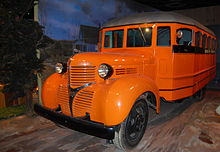
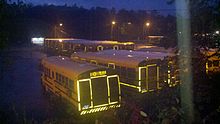
A key priority for a bus driver when driving as well as when loading and unloading students is proper sightlines around their vehicle; the blind spots formed by the school bus can be a significant risk to bus drivers, traffic, as well as pedestrians. In the United States, approximately ⅔ of students killed outside of the school bus are not struck by other vehicles, but by their own bus.[27]
To combat this problem, school buses are specified with sophisticated and comprehensive mirror systems. In addition, driver visibility and overall sightlines have become important considerations in vehicle redesigns; in comparison to past models, newer buses have much larger windscreens and fewer blind spots.
School bus yellow
[編集]Yellow was adopted as a standard color for North American school buses beginning in 1939. In April of that year, Dr. Frank W. Cyr, a professor at Teachers College at Columbia University in New York organized a meeting to establish national school bus construction standards, including the adoption of a standard shade of paint. The color which became known as "school bus yellow" was selected because black lettering on that specific hue was easiest to see in the semi-darkness of early morning and late afternoon. Officially, it is designated "National School Bus Chrome" (later renamed "National School Bus Glossy Yellow" as the lead was removed from the pigment).
Although it is not a government specification outside of the United States and Canada, school buses outside North America sometimes feature some shade of yellow in part or in whole, And while some areas without school services have conducted evaluations of American yellow style school buses,[28] other governments require their own distinctive paint schemes, often favouring other high visibility colours such as white or orange[29][30] that may better suit their own climate or conditions.
Retroreflective markings
[編集]School buses often operate in low-visibility conditions such as early morning or in poor weather as well as in rural areas. While their yellow paint color does give them a conspicuity advantage over other vehicles, darkness can make them hard to see. To improve their visibility, many state and provincial governments (for example, Colorado)[31] require the use of retroflective tape on school buses. Marking the length, width, height, and in some cases, identifying the bus as a school bus, reflective tape makes the vehicle easier to see for other drivers by the light of their headlamps and correctly perceive its size and position.
Federal Motor Vehicle Safety Standard 217 also requires that yellow, white, or red retroreflective tape be applied so as to mark all emergency exits, so rescue personnel can quickly find them in darkness.[32] The equivalent in Canada is almost identical; the only difference is that red cannot be used as a retroreflective color.
Traffic priority
[編集]By the mid-1940s, most states had traffic laws requiring motorists to stop for school buses while children were loading or unloading.[要出典] The justifications for this protocol are: 北米大陸では、スクールバスが生徒の乗降のために停車している間、周囲の乗用車は停止しなければならないことが定められており、それに関するルールは多くが1940年代中期までに制定されたものである。
- 子供は交通規範意識が未熟であり、急な道路横断が予想されるため
- Children, especially the younger ones, have normally not yet developed the mental capacity to fully comprehend the hazards and consequences of street-crossing, and under U.S. tort laws, a child cannot legally be held accountable for negligence. For the same reason, adult crossing guards often are deployed in walking zones between homes and schools.
- It is impractical in many cases to avoid children crossing the traveled portions of roadways
after leaving a school bus or to have an adult accompany them.
- スクールバスの車体が
乗降時、生徒と一般車の運転者 The size of a school bus generally limits visibility for both the children and motorists during loading and unloading.
Since at least the mid-1970s, all U.S. states and Canadian provinces and territories have some sort of school bus traffic stop law; although each jurisdiction requires traffic to stop for a school bus loading and unloading passengers, different jurisdictions have different requirements of when to stop. Outside of North America, the school bus stopping traffic to unload and load children is not provided for. Instead of being given traffic priority, fellow drivers are encouraged to drive with extra caution around school buses.
Warning lights and stop arms
[編集]
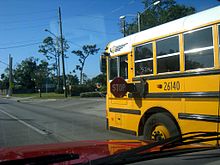
Around 1946, the first system of traffic warning signal lights on school buses was used in Virginia. This system comprised a pair of sealed beam lights similar to those employed in American headlamps of the time. Instead of colorless glass lenses, the warning lights utilized red lenses. A motorized rotary switch applied power alternately to the red lights mounted at the left and right of the front and rear of the bus, creating a wig-wag effect. Activation was typically through a mechanical switch attached to the door control. However, on some buses (such as Gillig's Transit Coach models and the Kenworth-Pacific School Coach) activation of the roof warning lamp system was through the use of a pressure-sensitive switch on a manually controlled stop paddle lever located to the left of the driver's seat below the window. Whenever the pressure was relieved by extending the stop paddle, the electrical current was activated to the relay. Plastic lenses for warning lights were developed in the 1950s, though sealed beams — now with colorless glass lenses — were still most commonly used behind them until the mid-2000s, when light-emitting diodes (LEDs) began supplanting the sealed beams.
With the adoption of FMVSS 108 in January 1968, four additional warning lights were gradually added to school buses; these were amber in color and mounted inboard of the red warning lights.[33] Intended to signal an upcoming stop to drivers, as the entry door was opened at the stop, they were wired to be overridden by the red lights and the stop sign.[33] Although 8-light systems were adopted by many states and provinces during the 1970s and 1980s, the all-red systems remain in use by some locales, such as Wisconsin, Saskatchewan and Ontario, Canada, as well as older buses in California.
To aid visibility of the bus in inclement weather, school districts and school bus operators add flashing strobe lights to the roof of the bus. Some states (for example, Illinois)[34] require strobe lights as part of their local specifications.
During the early 1950s, states began to specify a mechanical stop signal arm which the driver would swing out from the left side of the bus to warn traffic of a stop in progress. The portion of the stop arm protruding in front of traffic was initially a rectangle with stop painted on it. The U.S. National Highway Traffic Safety Administration's Federal Motor Vehicle Safety Standard No. 131 regulates the specifications of the stop arm as a double-faced regulation octagonal red stop sign at least 45 cm (17.7 in) across, with white border and uppercase legend. It must be retroreflective and/or equipped with alternately flashing red lights. As an alternative, the stop legend itself may also flash; this is commonly achieved with red LEDs.[35] FMVSS 131 stipulates that the stop signal arm be installed on the left side of the bus, and placed such that when it is extended, the arm is perpendicular to the side of the bus, with the top edge of the sign parallel to and within 6インチ (15 cm) of a horizontal plane tangent to the bottom edge of the first passenger window frame behind the driver's window, and that the vertical center of the stop signal arm must be no more than 9インチ (23 cm) from the side of the bus. One stop signal arm is required; a second may also be installed.[35] The second stop arm, when it is present, is usually mounted near the rear of the bus, and is not permitted to bear a stop or any other legend on the side facing forward when deployed.[35]
The Canadian standard defined in Canada Motor Vehicle Safety Standard No. 131, is substantially identical to the U.S. standard.[36]
Safety devices
[編集]

In addition to the warning devices that allow them to stop traffic around them when picking up or dropping off students, school buses are also equipped with a number of different safety devices to prevent accidents or injuries and for the purposes of security.
For the purposes of evacuation, school buses are equipped with a minimum of at least one emergency exit in addition to the main entry door. The rear-mounted emergency exit door is a design feature retained from when school buses were horse-drawn wagons and the entrance door was rear-mounted to avoid frightening the horses; in rear-engine school buses, the door is replaced by a exit window supplemented by a side-mounted exit door. Additional exits may be located in the roof (roof hatches), window exits, and/or side emergency exit doors. All are opened by the use of quick-release latches which activate an alarm. The number of emergency exits in a school bus depends on the size of the bus (its seating capacity) along with individual state regulations; Kentucky requires the most, with each full-size school bus having a total of eight emergency exits in addition to the entry door.
To inhibit pedestrians from walking close enough to the front of the bus that the hood obscures them from the driver's view, North Carolina and Connecticut are examples of states that requiring school buses to be equipped with crossing arms. These are devices which extend from the front bumper while the bus is stopped for loading or unloading.[37] By design, these force passengers to walk forward several feet forward of the bus (into the view of the driver) before they can walk across the road.
In the past, handrails in the entry way posed a potential risk to students; as they exited the bus, items such as drawstrings or other loose clothing could be caught if the driver was unaware and pulled away with the student caught in the door. To minimize this risk, school bus manufacturers have redesigned handrails and equipment in the stepwell area. In its School Bus Handrail Handbook, the NHTSA described a simple test procedure for identifying unsafe stepwell handrails.[38]
During the past two decades, video cameras have become common equipment installed inside school buses, primarily to monitor and record passengers' behavior. Video cameras have also been useful in determining the causes of accidents: on March 28, 2000, a Murray County, Georgia, school bus was hit by a CSX freight train at an unsignaled railroad crossing; three children were killed. The bus driver claimed to have stopped and looked for approaching trains before proceeding across the tracks, as is required by law, but the onboard camera recorded that the bus had in fact not stopped.[39]
As digital recording devices replace VHS cameras, a single device is replaced by multiple cameras throughout the bus, allowing for surveillance from multiple vantage points. Exterior-mounted cameras are mounted on the bus to photograph vehicles illegally passing the school bus when its stop arm and warning lights are in use (thus committing a moving violation).
Restraints and seating
[編集]Seat belts
[編集]In contrast to cars and other light duty passenger vehicles, school buses are typically not equipped with seat belts. In 1977, as provided in Federal Motor Vehicle Standard 222, the U.S. federal government required passive restraint and more stringent structural integrity standards for school buses instead of requiring lap seat belts. The passive restraint standards exempted school buses with a gross vehicle weight (GVWR) of over 10,000 pounds from requiring seat belts. A revised FMVSS 222 was set to take effect in October 2011 to require three-point, lap/shoulder belts in all newly manufactured Type A small school buses to improve occupant protection. The revised standard also introduces standards for testing lap/shoulder belt-equipped bus seats and the anchor points for the optional installation of these seat-belt systems in large school buses. Where in the past FMVSS 222 seat belt equipped seats could reduce passenger capacity by up to one third, NHTSA is recognizing new technology that allows belting either three smaller children or two larger children per seat.[40][41]
Whether seat belts should be a requirement has been controversial.[42] However, in October 2013, NASDPTS most recently stated at their annual transportation conference (NAPT) that they now fully support three-point lap-shoulder seat belts on school buses.[43] Currently, they are a requirement in at least five states:[44]
- Florida
- New Jersey (see below)
- New York
- California
- Texas
Of the states that equip buses with two-point lap seat belts (Florida, Louisiana, New Jersey and New York), only New Jersey requires seat belt usage by riders.[45] In other states, it is up to the district whether to require riders to use them or not.
In July 2004, California became the first state to require three-point lap/shoulder seat belts on all new Type A small school buses. A year later, this requirement was extended to large Type C and Type D school buses. Texas followed with its own three-point seat belt law for school buses in 2007 with a 2010 implementation date, if funding was available. So far, the Texas Education Agency has only received $2.6 million for optional grants.[46]
Compartmentalization
[編集]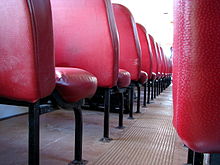
As a concept, compartmentalization was introduced in 1967 by safety researchers at UCLA. The premise behind compartmentalization is that improved seat design with high-back padded seats spaced close together (a maximum of 24インチ (61 cm) apart front to back) would better contain passengers in the event of a crash. Although not an element of compartmentalization, the UCLA researchers who conducted the 1967 tests on school buses concluded that after high back seats, next in importance to school bus passenger collision safety is the use of a three-point belt, a lap belt or other form of effective restraint. In April 1977, Federal Motor Vehicle Standard 222 changed the design of school bus seats from low metal-backed seats to the thickly padded seats still in use today.[41]
While compartmentalization is designed to help protect passengers in frontal and rear impact situations,[47] it does little to protect passengers in a side impact or rollover scenario.[48][49] Even in the situations where compartmentalization is designed to help protect passengers (front and rear impacts), injuries can still occur.[50]
Environmental compatibility
[編集]In theory, school buses reduce pollution in the same manner that carpooling does but on a much larger scale; in total, it is estimated that the approximately 480,000 school buses in the United States do the job of 17.3 million cars when it comes to transporting students.[51] However, as they are powered by internal-combustion engines, school buses are not a completely pollution-free method of transportation like biking or walking.
Some of the environmental drawbacks of school busing stem from the idling of engines while waiting for students to be unloaded and loaded at bus stops and at school. Since most school buses use diesel fuel, people standing or walking near the bus are exposed to exhaust fumes, which are believed to lead to health problems. Some older buses have been retrofitted with upgraded emission controls and diesel particulate filters,[52] and new buses meet more rigorous emissions standards with more advanced engines and emission control strategies such as Selective catalytic reduction; a bus meeting 2007-model year emissions standards is 60 times cleaner than a bus from 1990.[52]
Alternative fuels
[編集]
Although diesel fuel is most commonly used in large school buses (and even in many smaller ones), alternatives such as propane, CNG, and hydrogen have been developed to counter the drawbacks that diesel and gasoline-fueled school buses pose to the environment.
- Propane
- In the 1970s and 1980s, as a response to the gas crisis, propane conversions of gasoline engines were made available (most commonly those used in the General Motors B-Series). These conversions fell out of favor due to declining fuel prices and the increasing usage of diesel engines. Currently, Blue Bird Corporation offers a propane-powered option in its conventional Vision model bus.[53]
- Compressed natural gas (CNG)
- Compressed natural gas school buses were introduced by Blue Bird in 1991, using the Cummins ISL-G engine in its Type D All American rear engine body and chassis.[53] CNG is also available as an option from Thomas Built Buses on the Saf-T-Liner HDX.[54]
- Methanol
- Another conversion of existing engine architecture involved the use of methanol as a fuel source. In 1989, Crown Coach introduced the Supercoach Series II, a bus with a Detroit Diesel 6V92 converted to run on methanol instead of diesel. The same powertrain was offered into the 1990s by Carpenter on their Coach RE transit-style bus, but few were sold, and many methanol-fueled engines were later converted to diesel by their operators.
Hybrid-electric and battery-powered school buses
[編集]IC Bus, in collaboration with Enova Systems, unveiled the nation's first hybrid electric school bus in 2006 at the New York Association of Pupil Transportation (NYAPT) Show. This plug-in hybrid-electric vehicle (PHEV) school bus is claimed to reduce fuel consumption by as much as 40 percent compared to ordinary diesel buses.
Eleven states joined together for an exploratory purchase of 19 of these school buses from IC Bus. New York, California, Texas, Florida, Pennsylvania, Virginia, North Carolina, South Carolina, Arkansas, Iowa and Washington were the first states in the nation to test the diesel-electric hybrid school buses.[55] Since then, hybrids have slowly gained acceptance in the marketplace nationwide as the price premium has come down. Hybrids generally cost about $200,000 as of spring 2011, compared to more than $100,000 for a regular-sized diesel school bus.[56]
During the 1990s, battery-powered school buses were developed as conversions of existing vehicles; only a few were made, primarily for research purposes. In 2012, Trans Tech Bus introduced the eTrans, the first series-produced school bus that was battery-powered. Based upon the Newton truck from Smith Electric Vehicles, the eTrans was designed with an approximate range of 130 miles between charges.[57] In 2013, Trans Tech developed the SST-e, a conversion of a Type A school bus using the Ford E-Series rolling chassis.
Other uses
[編集]As a result of their large size and sturdy construction, vehicles built from school bus bodies are desirable for many other uses outside of student transport.
In education
[編集]An "activity bus" is a school bus used for providing transportation for students. Instead of being used in route service (home to school), the intended usage of an activity bus is for transporting students for extracurricular activities. Depending on individual state and provincial regulations, the bus used for this purpose can either be a regular yellow school bus or a dedicated unit for this purpose. Dedicated activity buses, while not painted yellow, are fitted with the similar interiors as well as the same traffic control devices for dropping off students (at other schools).
Multi-function school activity bus (MFSAB)
[編集]
In the past, groups transporting children and adults that did not need (or afford) a large bus commonly used 15-passenger vans to handle their transportation. However, such vehicles were at a disadvantage by comparison in terms of meeting safety regulations. To provide an alternative to 15-passenger vans (called "non-conforming vans" because they do not meet any safety standards for school buses),[58] bus manufacturers have designed vehicles as alternatives to 15-passenger vans. These are called Multi-Function SchoolActivity Buses (MFSABs).
The basic design of MFSABs differs from yellow school buses because of their intended use. As they are intended for point-to-point transportation instead of route service, MFSABs are not fitted with traffic control devices (i.e., red warning lights, stop arm) nor are they painted school bus yellow.[59] MFSAB buses are typically based on Type A school buses, although manufacturers offer MFSAB configurations for full-size buses as well.
For educational use, MFSABs are primarily used for extracurricular activities requiring transportation; in the private sector, they are typically purchased by child-care centers.
In law enforcement
[編集]
Larger police agencies may own their own buses for transporting large numbers of officers for a number of reasons. As these often offer higher capacity seating than other buses, the vehicles employed are based on school buses. Other police buses are custom-built as mobile command centers, using school bus bodyshells. Other uses by law enforcement often involve prisoner transport vehicles.
In community outreach
[編集]
With their large interior size, the body shells of school buses are among one of the most common type of bases for bookmobiles and mobile blood donation centers (bloodmobiles). Bookmobiles feature interior shelving for books and library equipment; bloodmobiles feature mobile phlebotomy stations and blood storage. Both types of vehicles spend long periods of time in the same place; to reduce fuel consumption, they often have on-board electrical generators to power their interior equipment and climate control.
In church use
[編集]Throughout the United States and Canada, school buses that are retired from front-line service have seen a second life as church buses; some churches purchase their buses new. While these buses are used to transport both adults and children, their usage as church buses varies from state to state. Buses converted to non-school use are prohibited by federal safety standards from displaying the "School Bus" lettering. Stop arms and signal lamps must be disabled or removed.[2] In some states, the bus is required to change its color from School Bus Yellow.
In church use, traffic law rarely gives buses priority to stop traffic. Alabama, Arkansas, Kentucky, Tennessee, and Virginia[60] are the only American states where school bus stop laws are similarly applied to church buses, if equipped with the flashing red lights used on school buses and operated in compliance with the same regulations as school buses. ((-))
Retirement
[編集]Template:Cleanup Template:Section OR

School buses are retired from service based on their age; some states and provinces have a specific age or mileage interval calling for their retirement, regardless of condition. In other cases, school districts and bus operators have a vehicle replacement schedule removing buses from service when it no longer is cost-effective to keep them in reliable and safe condition. Many buses that are retired are scrapped for spare parts; others are sold to such entities as churches, resorts or camps. School buses, as with other types of buses, are sometimes preserved and restored to their original condition by collectors and bus enthusiasts; museums and collectors have an interest in older and rarer models. Additionally, restored school buses appear alongside other period vehicles in television or film. Some retired school buses are converted into recreational vehicles (RVs); enthusiasts of this type of vehicle conversion are sometimes called Skoolies.
Former school buses may also be converted into farm utility vehicles for cattle feeding, fruit orchard maintenance and harvest, and other tasks. Most of the roof and body sides are removed, leaving only a cab for the driver enclosed with a rear wall. This creates a truck with an extremely long, flat bed. Many farms also use unconverted school buses (with usually just the name of the school district it once served and the "School Bus" lettering on the front and back blacked out) to transport their migrant workforce.
After their retirement from school use, NHTSA regulations require that the stop arms and warning signals of a school bus be removed or disabled.[2] In addition, if the bus is to transport passengers, the body must be painted a color other than School Bus Yellow and all school bus lettering must be removed.[2]
Export
[編集]Some retired school buses are exported to Latin America, Africa, or elsewhere. They are used as public transportation, school buses, municipal transport, or for the transport of migrant farmworkers. Once they are exported, their new owners often update the color scheme from school bus yellow to a variety of different colors.
School buses around the world
[編集]
Outside of North America, the yellow school bus is not as common; buses used for the purpose of student transport are typically closer in design to mass-transit buses. These buses may be painted yellow or other similar shades, but school bus yellow is not a government specification like it is on school buses from the United States or Canada and so is generally seen only on buses imported from North America. School buses outside of North America typically do not have traffic priority while loading or unloading students; school bus traffic stop laws differ from North American counterparts (if they exist at all).
China
[編集]Mainland China
[編集]In mainland China, purpose-built vehicles for transporting schoolchildren are not commonly used. Due to lack of buses and absence of regulation, overloading of buses with children in China for school routes is commonplace.[61] Consequently, accidents happen frequently.
Some Chinese bus manufacturers, such as Zhengzhou Yutong Group Co., Ltd., developed a school bus model, the ZK6100DA, to be purchased by schools in China. It was described as a "big-nose school bus" with a "classic western-style appearance" by one online newspaper.[62] FAW developed the similar CA6750. Both school buses hold approximately 35 student passengers.[63] In addition to large school buses, minibuses are sold by Chengdu and Maxus;[63] these school buses hold from 16 to 24 passengers.
In February 2012, the potential of American-imported school buses was explored as American manufacturers Blue Bird and IC Bus (Navistar) displayed buses at a bus industry trade show in Beijing.[64]
Hong Kong
[編集]In Hong Kong, younger students are transported between their homes and schools by "nanny vans". These vehicles are typically van-based and are smaller than a minibus. When nanny vans originated, they were regulated primarily by the schools and the van drivers. Today, in the interest of safety, nanny vans are government-regulated vehicles that run on fixed routes.
Europe
[編集]Germany
[編集]
In Germany, students travel to school on scheduled public train and bus routes. In most cases, these services operate at times to suit school hours and are not run during weekends and holiday periods, though the services are open to use by non-school-related travellers. Local authorities subsidise the routes but parents or guardians are required to pay a contribution to the cost of a season ticket for use of the services. Many scholars use their own bicycles to travel to school and may take these with them when a part of the journey is by train.
As student transport is heavily dependent on the public transport system in urban areas, most students are transported on mass-transit or intercity buses along with minibuses in support. To distinguish themselves from other buses, routes that transport students are required to have a destination sign worded "Schulbus" with a yellow background. German traffic law gives traffic priority to school buses unloading and loading students; school buses are to warn traffic using their four-way hazard lights.
The maximum speed for German school buses varies. While coaches are typically limited to 80キロメートル毎時 (50 mph), any buses with standing passengers are limited to 60キロメートル毎時 (37 mph).
- この記事はドイツ語版ウィキペディアにある同じ項目の記事のから翻訳された記事である。
Italy
[編集]
In Italy, school buses are typically painted yellow or orange. The vehicles used for student transport are usually minibuses or midibuses. As in North America, school buses run on fixed routes and stops.
While only a legal requirement for bus transporting Materne (preschool) students, school bus drivers are provided with an aide to manage the students on the bus.
- この記事はイタリア語版ウィキペディアにある同じ項目の記事のから翻訳された記事である。
Poland
[編集]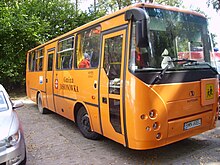
In Poland, school buses are used in a similar fashion as those in the United States, to connect residents of rural areas to schools located far away. While officially lettered autobus szkolny (Polish for "school bus"), they are colloquially known as gimbus.
Along with their counterparts in North America, school buses in Poland have several design features to differentiate them from standard buses. First, all school buses are painted orange. Inside, the drivers' compartment is not allowed to be blocked from the passenger compartment; however, any rear door cannot be directly accessed by the driver. All doors must lock at speeds above 5キロメートル毎時 (3.1 mph).
- この記事はポーランド語版ウィキペディアにある同じ項目の記事のから翻訳された記事である。
Russia
[編集]
In a fashion similar to school buses in North America, school buses in Russia are allowed to stop traffic (with both lights and alarms) when loading and unloading students at bus stops. School bus drivers are also accompanied by aides, who are given their own seating on the bus; buses also have onboard luggage space.
School buses transporting children are identified by the wording Перевозка детей (Transporting Children). All school buses are restricted to a maximum speed of 60キロメートル毎時 (37 mph)
- この記事はロシア語版ウィキペディアにある同じ項目の記事のから翻訳された記事である。
United Kingdom
[編集]In the United Kingdom, student transport by bus is usually provided by local scheduled public transport bus services. Dedicated bus services for school students are usually contracted out to local bus companies, using ordinary buses which are used for other purposes when not in use for school journeys.
To encourage students to travel to school by bus, North American-style yellow school buses were introduced in the late 1990s. West Sussex acquired American Blue Bird school buses produced in right-hand drive in 1997; these replaced outdated Leyland double-decker buses.[65] A number of other localities followed suit, including Cheshire in 1999.[66]
In the private sector, FirstGroup launched First Student UK in 2000. While initially using right-hand drive Blue Bird TC/2000s imported from the United States, the company switched to Turkish-produced BMC 1100 buses later in the decade. First Student UK school buses use the same monochromatic yellow livery required in North America.
MyBus is a group of bus contractors that use school buses solely for school transport. Buses are fitted with seatbelts, and full-time drivers are assigned to each route.
Body manufacturer Wrightbus of Northern Ireland has produced a 66-passenger bus body configured for school bus use, the Volvo-chassis-based Wright Eclipse SchoolRun, since 2006.
Disabled minibuses
[編集]Children with more complex needs or disabilities are often transported to special schools in purpose-built minibuses. Much like in the United States, these buses are bus bodies fitted to full-size van chassis. In Europe, the Ford Transit and the Mercedes-Benz Vario are popular donor chassis for such vehicles.
- School buses in the United Kingdom
-
A right-hand drive American-sourced school bus (Blue Bird TC/2000) operated by First Student UK.
-
The Wright Eclipse SchoolRun, a school bus body produced in Northern Ireland.
-
A special-needs school bus in London, England. Wheelchair ramp is below door.
North America
[編集]Canada
[編集]
Canadian school buses are similar to their U.S. counterparts both in terms of overall design and their usage by school systems. The primary functional difference is the adaptation to the bilingual population of Canada. In francophone Quebec, the signage on the outside of the bus is in French; the front and rear legends read écoliers"—French for "Schoolchildren" ("School Bus" translated into French is the much longer "autobus scolaire"). The stop signal arm legend may read arrêt, French for "Stop", though Canada Motor Vehicle Safety Standard 131 requires the legend to read stop.[36] In addition, all emergency exit designations and instructions are required to be bilingual.
As Canada does not use the customary system, instrument panel gauges are calibrated in metric units. School buses, like all other Canadian vehicles, are equipped with daytime running lights (DRLs).
Buses are sometimes marketed to customers in Canada differently in comparison to the United States. In one example, the Blue Bird All American is rebadged as the Blue Bird TX3 in Canada (and other export markets). Additionally, of the three regionally-focused brands sold by Collins Industries, only Corbeil is sold in Canada, due to its previous manufacturing base in Quebec.
Mexico
[編集]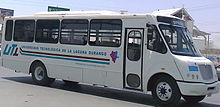
In Mexico, in addition to yellow school buses seen from the United States, various other types of buses are used in the role of student transport. As in the United States, many schools own their own fleets of school buses; school bus yellow is not a government regulation, so most buses are painted in individual school colors. Depending on capacity needs, vans, minibuses, and midibuses are also used. Among retired American school buses, some newer ones are imported into Mexico and put back into school service.
Unlike the United States and Canada, school-owned buses are not primarily used for route service (due to high cost); instead, they are often used for field trips and other related excursions. In addition to students using regular transit systems, several Mexican companies specialize in scheduled student transportation.
In Mexico City there is a special free bus service available to all the public in general; it is the "Puma-Bus" service, covering internal routes inside of the university complex located in "university city" at the south part of the same city, due to the extension of this scholar complex its operated in 10 routes that connect several points of the campus with Massive Transport Systems located near the complex (Metro, Metrobus and several local bus lines), all the routes operate from Monday to Friday, excepting those that gives services to cultural and sport centers, like the Universum Museum, Nezahualcoyotl Concert Hall and University Stadium. This service uses Low-Floor Mercedes Benz Citaro buses along with conventional units.
Oceania
[編集]Australia
[編集]In Australia, school buses vary in colour with yellow buses being rare.[67] As school route buses are almost universally run by direct government contract,[68] the livery of the bus is generally that of the contractor, with the bus commonly also being used for normal scheduled routes as required. In NSW, however, the State Government has begun a program to bring all public transport in the state under one livery[69] including strict livery regulations for new vehicles purchased for government contract use.[30] The style is typically the same as public buses in other countries, as demonstrated in the picture from Wagga Wagga, NSW (which is in the livery of the local operator). Buses used on school routes are required to bear 40 km/h (25 mph) speed limit signs on their rear and to flashing yellow lights on the front and rear, similar to those in the US and other places. When stopping or stopped, the lights flash indicating other drivers must not travel past the bus in either direction faster than 40 km/h (the same speed limit is used in 'school zones' on roads adjacent to schools at times when most students are expected to be arriving or leaving). Drivers must also cede right of way to all buses (school or otherwise) attempting to pull out from a stop. Dedicated bus lanes are common in larger cities, where buses are also allowed to move off first from traffic lights before other traffic is shown a green light. Some areas also have dedicated busways. Increasingly, jurisdictions are requiring new buses purchased for use on school routes to be fitted with seat belts and 'compartmentalisation' features, or even requiring students to use seatbelts at all times.
Private and public schools often have 'activity' style buses, sometimes in a colour matching the 'school colours' although more commonly with just the name and logo of the school on the side and/or front of the bus to save the cost of custom painting. They are used by many schools for smaller excursions, i.e. to transport a single sport team or class, in order save on external hire costs and are consequently generally also driven by school staff. In order to allow staff to drive them with a standard car or light truck licence these vehicles are generally quite small, 22 seat buses are very common in this role.
The vast majority of schools in Australia (both government and private) do not have their own buses for transporting children between the school and their home and thus most school children in Australia that do travel by bus travel on public transport buses, either on standard scheduled public transport routes, or on specific 'school travel' routes. Most school routes do not allow the general adult public to ride along with the children, although this does vary by location according to practicality (i.e. remote areas) and local regulation.
Many Australian school children travel 'free' on non fare paying bus services[70] to their local school or using a bus pass that they get issued at the beginning of the school year that covers transport with the relevant bus (and often other public transport such as train or ferry) network/s for travel to and from school only, for which the contractor in turn receives a government subsidy amount for each trip,[71] although specifics of the schemes vary from state to state, some only providing subsidy to remote or low income families.[72] Many thousands of children in Australia thus have to travel daily to school using a number of different public transport routes with different bus, train, tram and ferry networks. In most places, as of 2013, this is even achieved with a single pass.
New Zealand
[編集]In New Zealand, student transport is sometimes provided by the New Zealand Ministry of Education through school bus contractors or general bus companies. Bus companies generally have a fleet of older transit buses or coaches, different from the newer public service fleet vehicles to cater for school services.
While carrying students, buses are marked by either "SCHOOL", "SCHOOL BUS", "KURA" (Maori for "school"), or pictograms of children in black on a fluorescent chartreuse background, and a limited on the open road to 80 km/h (50 mph) . These signs all indicate that a motorist should slow to 20 km/h (12 mph) when passing a stationary bus in either direction[73][74]
関連項目
[編集]脚注・出展
[編集]- ^ Peter Daniels. "Stoke Newington Quakers - Early History." Retrieved 2010-04-05
- ^ a b c d e Highway Safety Program Guidelines: Pupil Transportation Safety. National Highway Traffic Safety Administration website. Retrieved 2010-06-23.
- ^ “FAQs”. American School Bus Council. 2010年11月27日閲覧。
- ^ a b c Mark Theobald (2004). Wayne Works. Coachbuilt.com. Retrieved 2010-04-26
- ^ a b The Gillig Story The Gillig Transit Coach and Pacific Schoolcoach Online Museum. (See "Gillig Bros. - the Early Years"). Retrieved 2010-04-07
- ^ Mark Theobald (2004). "Crown Coach". Coachbuild.com. Retrieved 2010-04-29
- ^ J. H. Valentine. “Crown Coach: California's Specialty Builder”. Tripod. 2010年4月27日閲覧。
- ^ a b c d Sandi Brockway (January 11, 2007). "Crown Coach Corporation (1932-1991)". Crown Coach Historical Society. Retrieved 2010-04-28
- ^ a b "Frank W. Cyr, 'Father of the Yellow School Bus,' Dies at the Age of 95". Columbia University press release (August 3, 1995). Retrieved 2010-04-07
- ^ “Highway Traffic Act, R.S.O. 1990, c. H.8”. E-laws.gov.on.ca. 2011年11月29日閲覧。
- ^ Rob Watson (June 13, 2000). “UK may get yellow school buses”. BBC News 2010年4月7日閲覧。
- ^ "The War, and becoming an industry leader". GilligCoaches.net. Retrieved 2010-06-15
- ^ “Collins Bus Corporation”. 2010年2月15日閲覧。 Corporate webpage with minor history
- ^ a b “School Bus types”. School Transportation News. January 3, 2010閲覧。
- ^ “short bus”. Urban Dictionary. 2011年11月29日閲覧。
- ^ “Federal Motor Vehicle Safety Standards”. School Transportation News (August 8, 2009). 2011年6月2日閲覧。
- ^ “Report to Congress: School Bus Safety Crashworthiness Research”. NHTSA (April 2002). 2011年6月2日閲覧。
- ^ “Spartan Chassis Executes Agreement With Lion Bus Inc. for Type C School Bus Chassis”. MarketWatch. (16 June 2011) 17 June 2011閲覧。
- ^ “Team”. Lion Bus. 17 June 2011閲覧。
- ^ “Blue Bird, Girardin Join Forces”. School Bus Fleet Magazine (February 19, 2010). 2010年4月14日閲覧。
- ^ “FAQs/Q: The school bus looks like it’s hardly changed in decades. Where’s the modernization”. American School Bus Council. 2010年12月3日閲覧。
- ^ School Bus Fleet Fact Book 2014. 59. pp. 34.
- ^ The Fourteenth National Congress on School Transportation. “National School Transportation Specifications and Procedures (2005 Revised Edition)”. p. 40. 2011年1月10日閲覧。
- ^ The Fourteenth National Congress on School Transportation. “National School Transportation Specifications and Procedures (2005 Revised Edition)”. pp. 7. 5 January 2014閲覧。
- ^ Dr Kristin Poland of NTSB, quoted at a hearing into a fatal 2012 bus crash at Chesterfield, Missouri, in "Buses safer than cars", Circular, Bus and Coach Association of New Zealand, August 2013.
- ^ “Federal Motor Vehicle Safety Standards”. School Transportation News (August 8, 2009). 2011年6月2日閲覧。
- ^ “Protecting Children from Their Own Buses by Mark D. Fisher”. January 29, 2006閲覧。
- ^ Rob Watson (June 13, 2000). “UK may get yellow school buses”. BBC News 2010年4月7日閲覧。
- ^ 引用エラー: 無効な
<ref>タグです。「WA School Bus Specifications including detail on required White Green and Orange Paint Scheme」という名前の注釈に対するテキストが指定されていません - ^ a b “Sydney Metropolitan Bus Service Contract-Schedule 8”. 2013年10月20日閲覧。
- ^ Colorado Minimum Standards Governing School Bus Transportation Vehicles Colorado Code of Regulations 301-25, Section 2251-R-54.02. Retrieved 2010-04-16
- ^ Bus emergency exits and window retention and release Code of Federal Regulations Title 49, Section 571.217. Retrieved 2010-04-15
- ^ a b . pp. 361. http://www.gpo.gov/fdsys/pkg/CFR-2011-title49-vol6/pdf/CFR-2011-title49-vol6-sec571-108.pdf.
- ^ Illinois school bus safety standards: Lamps, Reflectors, Signals Illinois Administrative Code Title 92 (Transportation), Sec. 442.615g. Retrieved 2010-04-16
- ^ a b c School bus pedestrian safety standards Code of Federal Regulations Title 49, Section 571.131. Retrieved 2010-4-15.
- ^ a b “Canada Motor Vehicle Safety Standard - Technical Standards Document 131”. Tc.gc.ca (2011年4月4日). 2011年11月29日閲覧。
- ^ Safety in the Danger Zone School Bus Fleet (September 1, 2007). Retrieved 2010-04-19
- ^ Handrail MechanicsSchool Bus Handrail Handbook. National Highway Traffic Safety Administration. Retrieved 2010-04-19.
- ^ Highway Accident Report - NTSB/HAR-01/03 National Transportation Safety Board (December 11, 2001). Retrieved 2012-07-28
- ^ Template:Cite webの呼び出しエラー:引数 url は必須です。Ryan Gray (August 7, 2009). “[{{{url}}} School Bus Seat Belts FAQ]”. School Transportation News. Template:Cite webの呼び出しエラー:引数 accessdate は必須です。
- ^ a b “School Bus Seat Belts”. School Transportation News. 2010年4月16日閲覧。
- ^ Janna Morrison (August 8, 2008). “NAPT Advocates Scientific Approach to Seat Belt Issue”. School Transportation News. 2010年4月16日閲覧。
- ^ Arroyo, Silvia (24 October 2013). “NASDPTS Alters Its Support of Three-Point Lap/Shoulder Seat Belts on School Buses”. School Transportation News 2 December 2013閲覧。
- ^ Susan Haigh (February 17, 2010). “Connecticut considers installing seat belts on school buses”. The Hour Online. 2010年4月16日閲覧。
- ^ Seat Belts in School Buses Transport Canada. Retrieved 2010-04-19
- ^ Ryan Gray (July 8, 2009). “The History of Seat Belt Development”. School Transportation News. 2011年6月2日閲覧。
- ^ “Compartmentalization”. School Transportation News. 2 December 2013閲覧。
- ^ “Review of Major School Bus Crashworthiness studies by thr National Transportation Safety Board”. National Coalition for School Bus Safety. National Coalition for School Bus Safety. 2 December 2013閲覧。
- ^ “SafeGuard school bus rollover crash test”. YouTube. IMMI. 2 December 2013閲覧。
- ^ “It's time for seat belts on school buses.”. SafeGuard Seating. 2 December 2013閲覧。
- ^ “Individual, Local and Global Community Impact - American School Bus Council”. 9 April 2014閲覧。
- ^ a b “FAQs/Q: Is it healthy for my child to ride the school bus?”. American School Bus Council. 2010年12月3日閲覧。
- ^ a b Blue Bird's Alternative Fuel Product Offerings Blue Bird Corporation. Retrieved 2010-4-16
- ^ Saf-T-Liner HDX Thomas Built Buses (pdf brochure). Retrieved 2010-04-16
- ^ “IC Corporation Works with Enova Systems to Supply First Hybrid School Buses That Can Attain Up To 40 Percent Increase in Fuel Efficiency - See more at: http://www.electricdrive.org/index.php?ht=display/ContentDetails/i/4688/pid/11284#sthash.QA84sQiT.dpuf”. 9 April 2014閲覧。
- ^ “Hybrids Might be the Way of the Future but Remain Slow in Coming to School Transportation Industry”. Stnonline.com (2011年3月4日). 2011年11月29日閲覧。
- ^ “Trans Tech goes green with electric school bus”. 22 January 2014閲覧。
- ^ “Are there other vehicles that can be used for school transportation? Vans?”. 2010年5月23日閲覧。
- ^ “Why do some school buses look different than others, for example in color?”. 2010年5月23日閲覧。
- ^ “LIS § 46.2-917.1. School buses hired to transport children.”. Code of Virginia. December 4, 2005閲覧。
- ^ 校车安全事故频发折射监管缺位 超载现象严重 Retrieved 2012-3-10
- ^ “Bigger nose means bigger safety for Qingdao school buses”. chinadaily.com.cn. (6 June 2011) 18 June 2011閲覧。
- ^ a b “China goes Schoolbus Crazy”. 31 December 2013閲覧。
- ^ “American-Style Schoolbuses Make Inroads In China”. 31 December 2013閲覧。
- ^ Di johan m b Nessun nome reale + Aggiungi contatto. “bluebird | Flickr –Condivisione di foto!”. Flickr.com. 2013年4月22日閲覧。
- ^ Di Wildmoreway Lena+ Aggiungi contatto. “Cheshire School Bus Bluebird V219EAL at Crewe (Flickr photo)”. Flickr.com. 2013年4月22日閲覧。
- ^ “Bus Australia Photo Gallery”. bus australia. 2013年10月20日閲覧。
- ^ “School bus contracts discourage fleet upgrades: MP”. Abc.net.au (2010年7月22日). 2013年4月22日閲覧。
- ^ “Out of the blue, more buses, all dressed alike”. smh.com.au (2010年12月22日). 2013年10月20日閲覧。
- ^ “Bus subsidy cuts hit students”. smh.com.au (2012年6月14日). 2013年10月20日閲覧。
- ^ “NSW School Student Transport Scheme”. 2013年10月20日閲覧。
- ^ “Queensland School Transport Assistance Scheme”. 2013年10月20日閲覧。
- ^ Speed limits on NZTA official New Zealand Road Code website, retrieved 2010-11-14
- ^ See this article on an instance of Maori bus sign usage in Rotorua:Principal remains adamant over 'kura' bus signson Rotorua Daily Post website, retrieved 2010-11-14
外部リンク
[編集]- School Bus Fleet Magazine - news magazine for student transportation professionals
- School Transportation News - news magazine for student transportation professionals
- U.S. DOT, NHTSA, Federal Motor Vehicle Safety Standards for School Buses (FMVSS)




